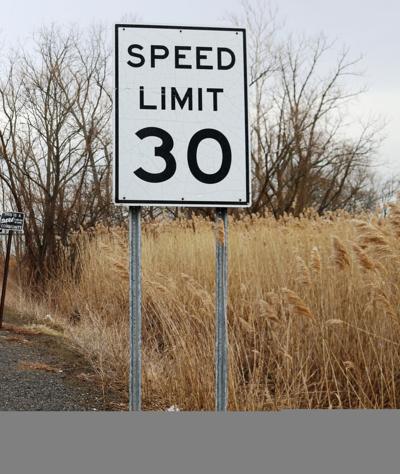HUDSON — The Common Council is considering a resolution to reduce the speed limit from 30 mph to 25 mph. If passed, the council would authorize and encourage Mayor Kamal Johnson to ask Assemblywoman Didi Barrett, D-106, to enact special legislation for the city.
The proposed resolution initially stated the change would not apply to truck routes in the city, which are state roads under the jurisdiction of the state Department of Transportation, but the council unanimously voted to remove that clause at its informal meeting Monday.
First Ward Alderwoman Rebecca Wolff asked if the clause could be removed.
City attorney Jeff Baker said the city could request the 25 mph limit to also apply to the state truck route.
“We can certainly request it,” he said. “We may not get it.” The city has a case to ask for the change and the routes are relatively small, Baker added.
“It’s not an unreasonable request,” he said.
The council unanimously passed the decision to remove the clause exempting the truck routes. They will vote on the resolution at their Dec. 15 formal meeting.
Residents of Hudson have long complained about vehicles traveling at an unsafe speed, according to the resolution. The speed limit is 30 mph, but drivers regularly exceed it, which causes a threat to the community, according to the resolution.
Recent initiatives to lower the speed limit came from 5th Ward residents, 5th Ward Alderman Dominic Merante said.
Fifth Ward residents spoke about speeding concerns at a town hall meeting at the beginning of Merante’s term, about two years ago, he said.
Fifth Ward residents wrote a letter to the Common Council on Nov. 14 with a petition attached in support of a reduced speed limit. More than 60 residents and visitors of “The Boulevards” 5th Ward neighborhood signed it.
Fifty-five signatures can be counted on the scan on the city website.
An accident on Parkwood Boulevard where a speeding car hit a porch, just missing a child, sparked the petition, Merante said.
“One of the more persistent safety hazards that residents and visitors of Hudson face is the speeds with which people drive up and down city streets,” according to the letter. “The fast traffic makes walking or bicycling on these streets dangerous.”
Traffic-calming measures like this one would make Hudson a more attractive environment for local business and tourism, the letter also states.
This wouldn’t be the first time traffic calming has been posed as a tourism issue.
Merante unsuccessfully asked for Tourism Board funding this fall to receive $5,700 for two speed radar signs like the ones on Harry Howard Avenue, to put on Glenwood Boulevard and Worth Avenue, Merante said.
The park entrance on Glenwood Boulevard and the city entrance on Worth Avenue are two areas with the highest speed complaints, Merante said.
“My philosophy was, you know, the increase, especially around Oakdale, they are related to tourism and increasing of the volume of cars,” he said. “So I’m working on other funding for the two speed radar signs to go in those spots.”
Merante contacted the Department of Transportation and Barrett’s office to see how the speed limit could be changed, he said.
Research shows a 5 mph reduction prevents the impact of accidents, he said.
Hudson Police Chief L. Edward Moore supports the resolution, although speeding is not as much of an issue as people think it is, he said.
“I’m supportive of the 25 [mph] because everybody knows that slower speeds correlate to less injuries — pedestrian and motor-vehicle injuries,” Moore said. “I think the average person thinks that cars are speeding with more frequency than actually happens.”
He cited the truck traffic study, which will be presented by the city Thursday.
In the study of 4,500 trucks and other vehicles, about 75%, or around 3,400, were operating between 30 mph and 35 mph on the truck route, Moore said. About 625 vehicles, or 13%, traveled over 35 mph, according to the study.
“We don’t see a lot of car accidents related to speeding,” Moore said. “Most of our car accidents are property damage accidents that have to do with driver error and disobeying traffic control devices.”
Most of the speeding complaints are at the entrances to the city at Harry Howard Avenue, South Third Street and Worth Avenue, Moore said. “When we do our traffic enforcements that’s where we tend to set up,” Moore said. “Now, granted, we, especially compared to other agencies, we don’t write a lot of speeding tickets.” The nature of Hudson’s short blocks means the officers don’t see as many speeding violations within the city, Moore said. “We tend to address the speeders on those flats coming into our city,” Moore said.
A fatal motorcycle accident Oct. 14 near Columbia Memorial Health was an outlier, Moore said. There have been no other fatal accidents since he has worked in Hudson, for eight years, and the last he was told of was in 1985, he said.
“This idea has been around for quite some time, so it’s great to take the first step in what will probably be a long process with the state,” Common Council President Thomas DePietro said.
Merante has not received pushback for his efforts, he said.
“Ever since I can remember the speed in the city has been an issue, so hopefully this is another tool to reduce in traffic calming,” Merante said.
The speed limit change is part of a larger puzzle to make the streets more pedestrian friendly, Merante said.
“This is just a first stage of other things that need to be done to make this reality,” Merante said of the resolution. “We’re going to have to do some investment in signage when it happens ... This is just a first stage, but it’s a very important stage.”










